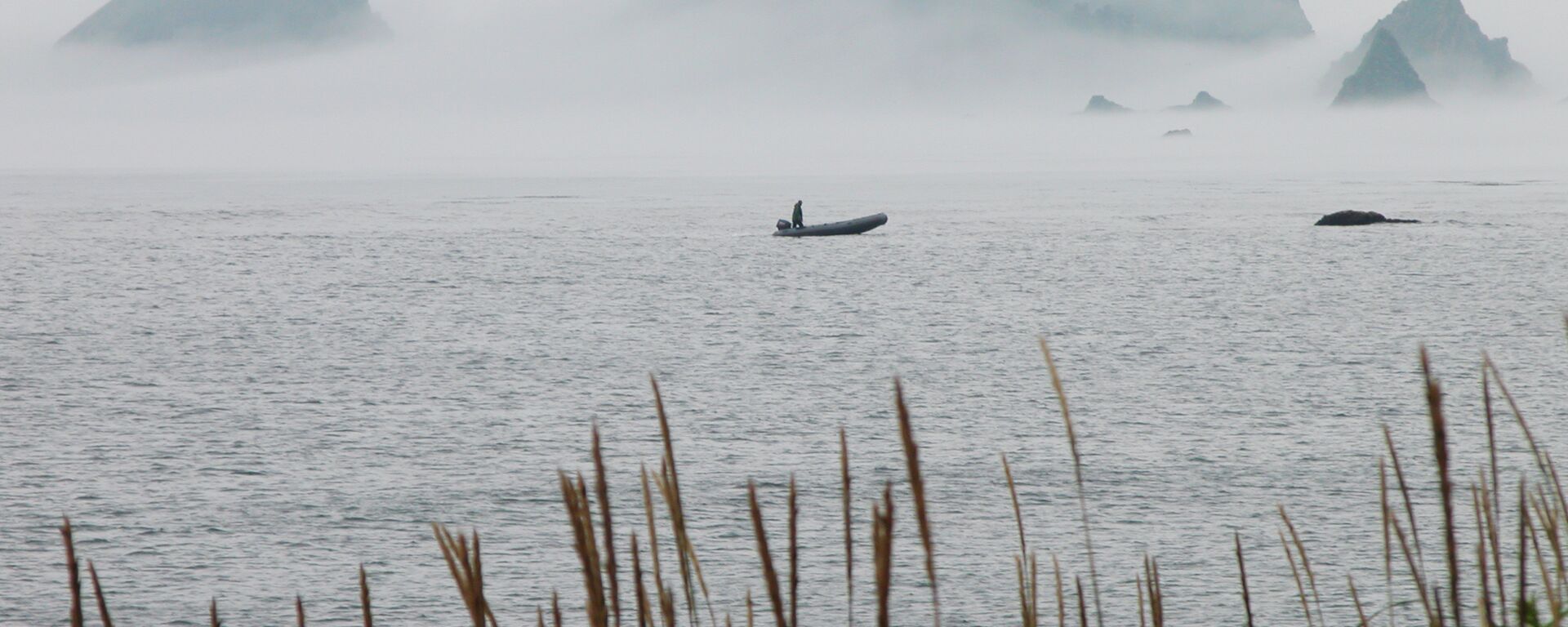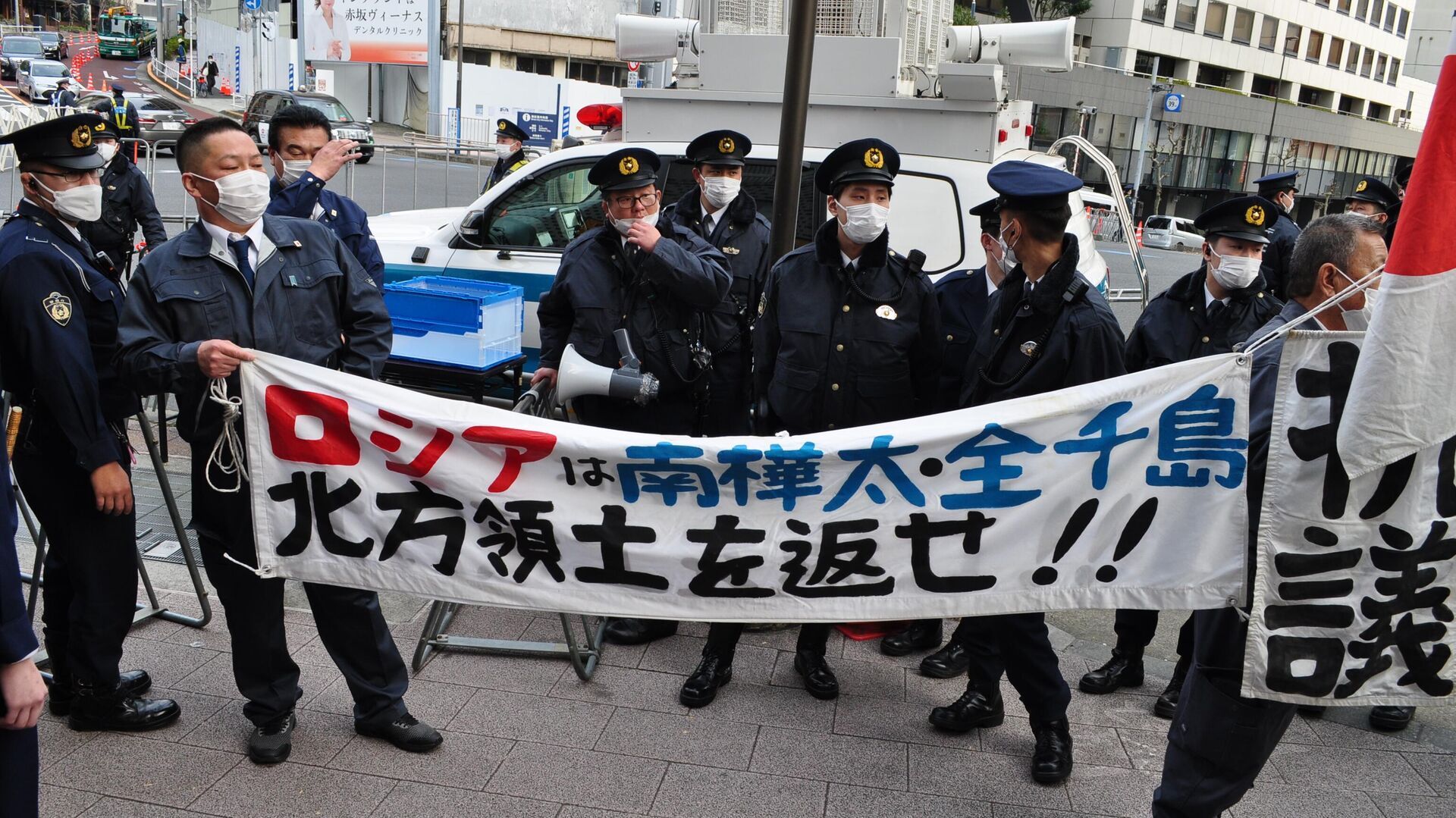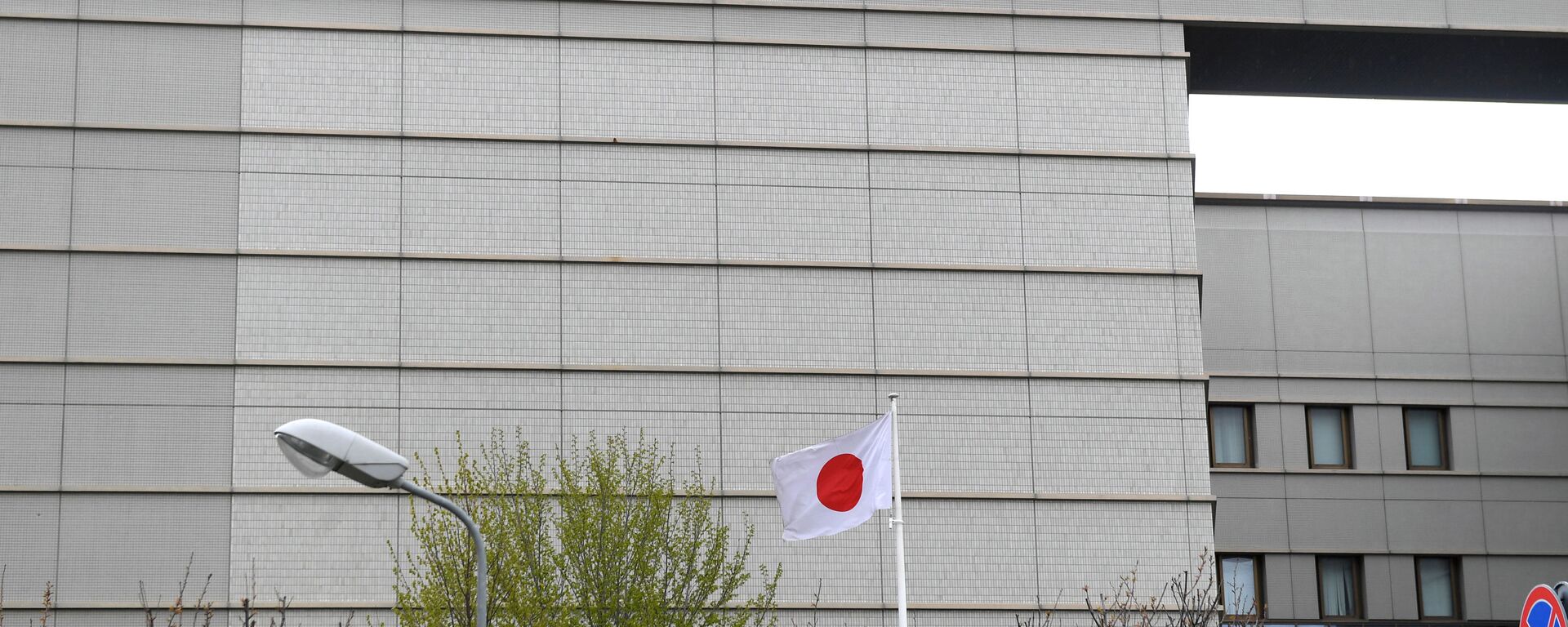https://sputnikglobe.com/20230207/treaty-of-shimoda-not-cause-for-protests-but-proof-of-russia-japan-permanent-peace--friendship-1107049440.html
Treaty of Shimoda: Not Cause for Protests, but Proof of Russia-Japan Permanent Peace & Friendship
Treaty of Shimoda: Not Cause for Protests, but Proof of Russia-Japan Permanent Peace & Friendship
Sputnik International
On February 7, 1855, the Russian Empire and the Empire of Japan signed the Japanese-Russian Friendship Treaty in the city of Shimoda, Article II of which demarcated the border between the two countries for the first time.
2023-02-07T15:54+0000
2023-02-07T15:54+0000
2023-02-07T15:54+0000
world
japan
russia
bilateral relations
territorial disputes
kuril islands
https://cdn1.img.sputnikglobe.com/img/07e7/02/07/1107050037_0:157:3083:1891_1920x0_80_0_0_5c3a2aba9d340791767677a0afa8d59a.jpg
However, behind the subtleties of demarcation that Japanese nationalists are eager to escalate today, the main point of the treaty remains unnoticed. The key statement is contained in Article I of the treaty, which reads: "Henceforth there shall be permanent peace between the Empire of Russia and the Empire of Japan, including the security of persons and property of both nations."Northern Territories Day, a Day of NeglectIn 1981, at the height of the Cold War, the Japanese government, in order to intensify its propaganda campaign for the "return" of the Kuril Islands, established Northern Territories Day and set it on February 7, the day of the signing of the Shimoda Treaty, making the treaty the starting point of the settlement of the dispute over the four islands in the Kuril chain. However, this approach does not correspond with historical truth, according to the Russian side.Undeniable Russian TerritoryAll of the Kuril Islands up to Hokkaido were part of the Russian Empire during the reign of Empress Catherine II, as recorded in the geographical atlases of the time. At that time, Japan was limited to the Matsumae Principality in the south of Hokkaido. The head of Japan's central government, Matsudaira Sadanobu, acknowledged this in a document in 1792: "Nemuro in the north of Hokkaido is not Japanese land." Moreover, the Kuril Islands north of Hokkaido could not be "ancestral Japanese territories."In the late 18th century, however, Japanese armed detachments began to raid the Southern Kurils. According to surviving eyewitness accounts, the Japanese tipped over Russian signposts and erected posts with their own inscriptions. At the same time, the invaders tore down and destroyed Orthodox crosses placed on the islands. This is how the transformation of the Southern Kuril Islands into the "territory of the Japanese ancestors" took place.Nikolai Rezanov, a Russian state official who went to Japan on an official mission in 1805, demanded that the Japanese Empire respect the established borders and not extend its possessions beyond the northern tip of Hokkaido Island. In response, Rezanov heard nothing but insults.Admiral's ConcessionThe next Russian mission, led by Vice-Admiral Yevfimy Putyatin, arrived in Japan in 1853. The first Russian-Japanese negotiations in Nagasaki on the establishment of interstate relations, trade, and the definition of the state border were difficult and intermittent, but finally, on February 7, 1855 the Treaty of Shimoda was signed, which in nine articles regulated all aspects of bilateral relations and the state border.Russian diplomacy still considers the signing of the Treaty of Shimoda as a diplomatic success of Putyatin's mission, despite the territorial concessions made by the admiral. The signing of the treaty took place against the backdrop of Russia's difficult foreign policy situation resulting from the failures in the Crimean War, and the Russian side at that time had no ability to exert forceful pressure on Japan. Putyatin, on the other hand, was able to reach an agreement purely through negotiations, although the initial demands of the Japanese side were very harsh: the Russian withdrawal from Sakhalin and the transfer of the possession of all the Kuril Islands to Japan.War Cancels TreatiesSince the Treaty of Shimoda, the state of Russo-Japanese relations has changed many times, as has the line of the state border. Under the Treaty of St. Petersburg in 1875, Sakhalin was ceded to Russia in exchange for all 18 Kuril Islands. Then, as a result of the Russo-Japanese War of 1905, Russia ceded the southern half of Sakhalin (up to the 50th parallel) to Japan. And in 1946, after the end of World War II, in accordance with international treaties, Sakhalin and the Kuril Islands were fully incorporated into the USSR.After Japan was defeated in World War II and signed the Act of Unconditional Surrender, it lost the right to refer to previous treaties and agreements. According to the legal content of the concept of total and unconditional surrender, a country that signs such an act loses its prewar subjectivity, which automatically nullifies all treaties and agreements previously concluded. Thus, Japan's territorial claims without legal and historical justification fall under the concept of "revanchism" - the desire to revise the results of World War II confirmed by international agreements and documents.Moscow had refused to negotiate a peace treaty with Japan in response to Tokyo's unfriendly moves toward Russia.Groups of right-wing activists protested in front of the Russian Embassy in Tokyo on the so-called Northern Territories Day on February 7. A Sputnik' correspondent visited the scene to assess the scale of the demonstrations.In connection with the protests, the entire Azabudai district, where the Russian Embassy in Tokyo is located, was guarded from two sides by reinforced police units. According to police, the protesters began their action at 9 a.m.The protesters traditionally gathered at the intersection of Azabu and Sakura Streets. The police set up special fences for them.The demonstrators were allowed to leave the fences and enter the street leading to the embassy only with police permission and a police escort. Only three or four people at a time were allowed to enter. Chanting slogans was allowed only on the opposite side of the street from the embassy, surrounded by police."Russia, which doesn't keep its own promises, get out of Japan!" and "Putin, give back the Northern Territories! Give back the islands!" could be heard chanted by those who had gathered to protest. The demonstrators held banners and placards that read, “Let's take back the Northern Territories from Russia!”Cars with right-wing propaganda, using loudspeakers to call for the return of the Northern Territories, also lined the streets adjacent to the Azabudai district. As soon as the police noticed these vehicles approaching, they would run up with a placard warning that loudspeakers could not be used in accordance with Article 6 of the "Law for the Maintenance of Peace in the Areas around the National Diet Building and Foreign Diplomatic Institutions."Around 1 p.m., the number of protesters was about 10 people. Sputnik asked the police if there had been more protesters in the morning, but the officers confirmed that the number was about the same. By 3 p.m., the fences where the protesters had gathered were already empty.So far, there is no information about clashes between ultra-right activists and police or other incidents. The press service of the Russian Embassy also confirmed that no incidents had been reported.
https://sputnikglobe.com/20230207/japan-seeking-to-reach-peace-treaty-with-russia-on-south-kurils-prime-minister-1107037383.html
https://sputnikglobe.com/20190622/russian-flag-kurils-putin-1076017461.html
https://sputnikglobe.com/20190806/russian-foreign-ministry-summons-japans-ambassador-over-kurill-islands-related-protests-in-tokyo-1076484252.html
japan
russia
Sputnik International
feedback@sputniknews.com
+74956456601
MIA „Rossiya Segodnya“
2023
Sputnik International
feedback@sputniknews.com
+74956456601
MIA „Rossiya Segodnya“
News
en_EN
Sputnik International
feedback@sputniknews.com
+74956456601
MIA „Rossiya Segodnya“
Protest in front of the Russian Embassy in Tokyo
Sputnik International
Groups of right-wing activists protested in front of the Russian Embassy in Tokyo on the so-called Northern Territories Day. A Sputnik' correspondent visited the scene to assess the scale of the demonstrations.
2023-02-07T15:54+0000
true
PT1M00S
Sputnik International
feedback@sputniknews.com
+74956456601
MIA „Rossiya Segodnya“
russia, japan, russian-japanese relations, treaty of shimoda, kuril islands
russia, japan, russian-japanese relations, treaty of shimoda, kuril islands
Treaty of Shimoda: Not Cause for Protests, but Proof of Russia-Japan Permanent Peace & Friendship
On February 7, 1855, the Russian Empire and the Empire of Japan signed the Japanese-Russian Friendship Treaty in the city of Shimoda, Article II of which demarcated the border between the two countries for the first time.
However, behind the subtleties of demarcation that Japanese nationalists are eager to escalate today, the main point of the treaty remains unnoticed. The key statement is contained in Article I of the treaty, which reads: "Henceforth there shall be permanent peace between the Empire of Russia and the Empire of Japan, including the security of persons and property of both nations."
Northern Territories Day, a Day of Neglect
In 1981, at the height of the Cold War, the Japanese government, in order to intensify its propaganda campaign for the "return" of the Kuril Islands, established Northern Territories Day and set it on February 7, the day of the signing of the Shimoda Treaty, making the treaty the starting point of the settlement of the dispute over the four islands in the Kuril chain. However, this approach does not correspond with historical truth, according to the Russian side.
"We are disheartened by the attempts of some Japanese political forces and public organizations to artificially link the Treaty of Shimoda with the current issue of the peace treaty between Russia and Japan, thereby justifying Tokyo's territorial claims on our country... The Treaty of Shimoda, without diminishing its historical significance, has nothing to do with the conclusion of the treaty," the Russian Foreign Ministry said.

7 February 2023, 09:40 GMT
Undeniable Russian Territory
All of the Kuril Islands up to Hokkaido were part of the Russian Empire during the reign of Empress Catherine II, as recorded in the geographical atlases of the time. At that time, Japan was limited to the Matsumae Principality in the south of Hokkaido. The head of Japan's central government, Matsudaira Sadanobu, acknowledged this in a document in 1792: "Nemuro in the north of Hokkaido is not Japanese land." Moreover, the Kuril Islands north of Hokkaido could not be "ancestral
Japanese territories."
In the late 18th century, however, Japanese armed detachments began to raid the Southern Kurils. According to surviving eyewitness accounts, the Japanese tipped over Russian signposts and erected posts with their own inscriptions. At the same time, the invaders tore down and destroyed Orthodox crosses placed on the islands. This is how the transformation of the Southern Kuril Islands into the "territory of the Japanese ancestors" took place.
Nikolai Rezanov, a Russian state official who went to Japan on an official mission in 1805, demanded that the Japanese Empire respect the established borders and not extend its possessions beyond the northern tip of Hokkaido Island. In response, Rezanov heard nothing but insults.
The next Russian mission, led by Vice-Admiral Yevfimy Putyatin, arrived in Japan in 1853. The first Russian-Japanese negotiations in Nagasaki on the establishment of interstate relations, trade, and the definition of the state border were difficult and intermittent, but finally, on February 7, 1855 the Treaty of Shimoda was signed, which in nine articles regulated all aspects of bilateral relations and the state border.
The main idea of the treaty was to establish "permanent peace and sincere friendship between Russia and Japan." The ports of Shimoda, Hakodate, and Nagasaki were also opened to Russian ships. Russia received Most Favored Nation treatment in trade and the right to open consulates at these ports. Russia's national border now ran north of Iturup, which returned the islands of Kunashir, Iturup, Shikotan, and Habomai to Japan. Sakhalin, however, remained the joint and inseparable property of the two countries.
Russian diplomacy still considers the signing of the Treaty of Shimoda as a diplomatic success of Putyatin's mission, despite the territorial concessions made by the admiral. The signing of the treaty took place against the backdrop of Russia's difficult foreign policy situation resulting from the failures in the Crimean War, and the Russian side at that time had no ability to exert forceful pressure on Japan. Putyatin, on the other hand, was able to reach an agreement purely through negotiations, although the initial demands of the Japanese side were very harsh: the Russian withdrawal from Sakhalin and the transfer of the possession of all the Kuril Islands to Japan.
Since the Treaty of Shimoda, the state of Russo-Japanese relations has changed many times, as has the line of the state border. Under the Treaty of St. Petersburg in 1875, Sakhalin was ceded to Russia in exchange for all 18 Kuril Islands. Then, as a result of the Russo-Japanese War of 1905, Russia ceded the southern half of Sakhalin (up to the 50th parallel) to Japan. And in 1946, after the end of World War II, in accordance with international treaties, Sakhalin and the Kuril Islands were fully incorporated into the USSR.
After Japan was defeated in World War II and signed the Act of Unconditional Surrender, it lost the right to refer to previous treaties and agreements. According to the legal content of the concept of total and unconditional surrender, a country that signs such an act loses its prewar subjectivity, which automatically nullifies all treaties and agreements previously concluded. Thus, Japan's territorial claims without legal and historical justification fall under the concept of "revanchism" - the desire to revise the results of World War II confirmed by international agreements and documents.
Moscow had refused to negotiate a peace treaty with Japan in response to
Tokyo's unfriendly moves toward Russia.
Groups of right-wing activists protested in front of the Russian Embassy in Tokyo on the so-called Northern Territories Day on February 7. A Sputnik' correspondent visited the scene to assess the scale of the demonstrations.
In connection with the protests, the entire Azabudai district, where the Russian Embassy in Tokyo is located, was guarded from two sides by reinforced police units. According to police, the protesters began their action at 9 a.m.
The protesters traditionally gathered at the intersection of Azabu and Sakura Streets. The police set up special fences for them.
The demonstrators were allowed to leave the fences and enter the street leading to the embassy only with police permission and a police escort. Only three or four people at a time were allowed to enter. Chanting slogans was allowed only on the opposite side of the street from the embassy, surrounded by police.
"Russia, which doesn't keep its own promises, get out of Japan!" and "Putin, give back the Northern Territories! Give back the islands!" could be heard chanted by those who had gathered to protest. The demonstrators held banners and placards that read, “Let's take back the Northern Territories from Russia!”
Cars with right-wing propaganda, using loudspeakers to call for the return of the Northern Territories, also lined the streets adjacent to the Azabudai district. As soon as the police noticed these vehicles approaching, they would run up with a placard warning that loudspeakers could not be used in accordance with Article 6 of the "Law for the Maintenance of Peace in the Areas around the National Diet Building and Foreign Diplomatic Institutions."
Around 1 p.m., the number of protesters was about 10 people. Sputnik asked the police if there had been more protesters in the morning, but the officers confirmed that the number was about the same. By 3 p.m., the fences where the protesters had gathered were already empty.
So far, there is no information about clashes between ultra-right activists and police or other incidents. The press service of the Russian Embassy also confirmed that no incidents had been reported.







